
_____________________
THE FLAT
RESPONSE
_____________________Martin Colloms gives a listen to
three panel loudspeakers: the
Apogee Duetta II, Martin-Logan CLS
(UK), and Magneplanar MGIIIa
Panel speakers are back in fashion. After years of determined effort on the part of a few established manufacturers, the number of these designs has seen a marked increase, and many new exotic models have appeared. Stereophile has recently reviewed two leading examples of the genre, the $2780/pair Apogee Duetta and the $2490/pair Martin-Logan CLS, (both In Vol.9 No.7). To fudge by the tone of letters arriving at the magazine's offices, the reviews generated heated controversy John Atkinson asked me, therefore to conduct an In-depth examination of the two models, to give a fuller picture of what these speakers are capable of. Lurking In the wings, and at present perhaps unfairly overshadowed, is the $1995/pair Magneplanar MGIII in its latest (a) form; I decided to Include it in the review, its influence being too great to Ignore.
I hope to present rather more data than contained in a conventional review. To begin with, there will be new supporting evidence on the sound of the Duetta and CLS generated in alternative rooms. Furthermore, the review samples were of recent vintage, with the Duetta In true Mk.II form after some Mk.I gestation difficulties, and the Logan equipped with the latest electronics. The CLS frequency balance had also been changed for the UK market. This Involved the substantiation of a higher resistor value in the treble section of the equalizing/matching network to provide a richer, and in my view, more accurately balanced sound. (Those comparing my remarks with JA's In Vol.9 No.7 should bear in mind that JA's samples had not been so modified.) As an alternative to a classic comparative review, JA requested a preliminary exploration of the principles of these two speakers to discover how their fundamental operation affects their performance and sound. This is a tall order, and requires that judgments be made in the context of the technology used. This part of the report should not be taken too literally in terms of the analysis of sound quality; if audiophiles were fully briefed on the limitations of most designs, many would refuse to buy a speaker at all. What does matter is the subjective judgment of the final result, governed by price and expectation. As the report developed, the Duettas and the Logans begin to position themselves at extremes of technology and specific performance, while the Magneplanar emerged as the classic, balanced, middle-of-the-road contender.
Design Compromises
Although radically different in appearance, the Duetta and the CLS are both medium-sized, floor-standing, open-panel speakers. The Duetta is a two-way system, with a moderately sized, broad-band ribbon tweeter working through the upper mid and treble ranges. It Is related to the three-way Scintilla, which uses 2 composite multiple-ribbon system for the mid and treble range.
The number of ways is crucial to a design, since no single transducer can properly encompass the breadth of the audible frequency range. From the design viewpoint, the more ways - i.e., the greater the number of divisions of the frequency range the more freedom there is for the engineer to trim and balance the frequency response to provide a natural sound. Conversely, with a low number of ways the designer has to fight for continuity and an even power over the range, not always with complete success. Increasing the ways however, makes it more difficult to design a well-integrated full-range system out of proportion to the Increase in complexity.
Apogee has pioneered the use of modern ribbon technology, and In the case of the Duetta, this description is certainly true for the HF unit. Here, a tall, pleated aluminium foil/Kapton ribbon with three conducting paths is suspended between the poles of a powerful, linear, open magnet. The radiation is bi-directional and bipolar, the energy behind being out of phase by 180 degrees with that for the front. Unless placed very close to a back wall, this will not result in specific cancellation, since by the time wall reflected rear waves have combined with the direct radiation; their phase is randomly indeterminate. Suppose the panel is typically placed at five feet from the back wall, and the listener is 15 feet from the speaker. At the low frequency end of the range handled by the tweeter ribbon, say 1kHz, the listener is 15 wavelengths away from the front-panel sound, and 25 wavelengths from the reflected sound to the rear. Given normal room reflections, specific cancellations will be diffused and of small significance; with reducing frequency, however, this factor will assume Increasing Importance.
The lower frequency range of the Duetta is handled by a stretched film diaphragm, tensioned and supported over its whole boundary perimeter, and referred to by Apogee as a ribbon. Its motion is akin to a drum skin, as is that of the Magneplanars and the vast majority of electrostatics. This is quite distinct from the piston-like, push-pull, action of a freely suspended ribbon whose fundamental to-and-fro resonance may be so low as to occur below audibility. At present, it is inconceivable that a loudspeaker could be made to operate fullrange in a true ribbon form. The magnet system would be so huge that no-one would be able to move it. It is also likely that such a design would overload prematurely at subsonic frequencies.
Apogee has overcome, in a number of ways, many of the fundamental resonance problems of a stretched diaphragm. The moving element of their woofer is a laminate combination of aluminium foil and Kapton plastic tape with good self-damping properties. The element is generally pleated in the horizontal direction to increase its resistance to bending, while the shape is semi-trapezoidal to maximize its geometric asymmetry and thus disperse resonant modes. Finally, the upper and lower sections of the diaphragm are differentially tensioned to provide a broad, double-tuned low-frequency resonance, rather than one of a higher Q.
Several factors control the frequency response of an open panel. At low frequencies, the bass rolls off at 6dB/octave and is generally augmented by some deliberate diaphragm resonance. After passing through a fairly level region, the output begins to fall naturally and the drive signal must be crossed over to the next driver before this happens-in the case of the Duetta, around 500Hz. For the mid-treble ribbon element, the low-frequency roll-off begins at over 1kHz, and the crossover overlap is deliberately broad to help account for this. Once again, given some consideration of the acoustics of the vertical slot in which the tall ribbon tweeter operates, and the mild canting of the element to improve the vertical directionality, the treble ribbon's output falls at the top of its band. In the case of the Duetta, this is at frequencies above 12kHz. The Scintilla's more extended top-end response is assured by the final set of four half-inch ribbons, which augment the output from the mid-treble ribbon.
The Duetta's treble ribbon is a wide-range transducer, covering a range from some 500Hz to 22kHz, and is of exceptional sound quality. Advantages of this large ribbon include a virtual absence of resonance or coloration, with great acoustic transparency - no physical obstruction before or behind the driver element, plus direct coupling of the applied electro-mechanical force to the air. The virtual line source form achieves good horizontal directivity. However, owing to the wide magnet gap, which is necessary to accommodate the conductor, the tweeter does not offer much sensitivity. Running the three conductor elements of the ribbon in series brings the load impedance to 4 ohms, but the sensitivity remains very low, in speaker terms, at typically 78dB/W (this is an 8-ohm watt), which is some 10dB below the average. There are penalties to pay for this low sensitivity in terms of required amplifier power.
The Duetta's low-frequency driver is necessarily subject to some resonance modes and, in addition, suffers from some acoustic obstruction due to the perforated steel-plate baffle used to support the massive array of planar magnets. These pro vide the distributed magnetic field associated with the zigzag current flow of the diaphragm conductor pattern. The acoustic window area of the bass section is not very high, though if this were increased, panel rigidity would suffer. The bass driver, having a one-sided magnetic field, is driven in single-ended rather than the preferred push-pull mode. In theory, this would predict higher distortion levels, but in practice, the distortion from such a large radiating area as quite negligible, even at realistically high sound-pressure levels.
Due to their large area, the Duetta diaphragms radiate heat well, providing a high power handling which is necessary In view of the low sensitivity. A particular feature of the Apogee drive system is its very high inherent linearity, resulting in a freedom from the compression effects apparent in many moving-coil systems, as well as in some electrostatics when the peak handling limits are exceeded.
Turning to the Martin-Logan CLS fullrange electrostatic, this open-panel speaker must also suffer the low-frequency roll-off limitation of a finite baffle, and copes with this by means of a designed resonance at 50Hz. The electrostatic principle is attractive in many respects, not least because it allows the use of an extremely light diaphragm - so light, in fact, that its vibratory contact with the air molecules may be used as a palliative, controlling, damping mechanism. Light diaphragms can move quickly, promising good high-frequency response, while their low inertia assures a low level of stored energy, promising an accurate transient response.
In principle, the electrostatic driver is very efficient in its conversion of moving electric charge into acoustic power. Problems arise, however, in interfacing the necessarily large electrostatic element to the room, as well as to the power amplifier. The science of electrostatics is the science of high voltages, with the polarizing field established by as much as 7kV applied to the inner-shielded diaphragm. Ideally, the fixed-mesh electrodes on either side of the diaphragm need to be driven in push-pull at upward of 500V, and require isolation from the user. (In the case of the Quad, the electrodes are protected behind grounded mesh screens.) A thick, tough, black plastic insulating coating Is applied to the CLS electrodes; these simultaneously form the external grilles of the speaker.
High-ratio step-up transformers need to be used to couple the amplifier to the system, while the input characteristic is not one that allows for optimum power transfer. An electrostatic offers an input characteristic that is predominantly capacitive, hardly an ideal load. By the time these considerations have been taken into account, as well as the need to improve the poor dispersion of a single large diaphragm, the much-vaunted efficiency has been whittled away. Nevertheless, most electrostatics have a basic sensitivity of around 85dB/W (8 ohms), which is rather better than that achieved by present large ribbon systems.
The CLS diaphragm is unusual, for although it is only 0.004" thick, and consequently very light (the whole system is reckoned to weigh the same as one cubic inch or 16.4ml of air), it is formed from a pretty rigid plastic and is almost self-supporting. No mechanical damping is used in the diaphragm; its stretched skin and plate vibration modes are partially controlled in the first instance at the boundaries, where a lossy foam-plastic mounting is used, and by the acoustic impedance of the air load imposed on the diaphragm. For comparison, the Quad ESL-63 uses a 0.00137" diaphragm, with 0.001" plastic film for the dust-cover membranes. The CLS uses a density of Mylar similar to quad, giving a total mass of around 0.02gm. (The ESL-63 is even more extraordinary, its diaphragm weighing just 0.003gm, or 3 milligrams, not too far removed from the tip mass of a pickup cartridge!) Another interesting comparison is with a typical wide-band moving-coil dome tweeter, where the moving mass is normally around 200mg. Quads enjoy higher levels of air-damping than Martin-Logans and, in addition, use an interlayer of the sheerest gauze to provide necessary resistive mechanical contact damping to the diaphragm surface.
From its appearance it is obvious that the CLS diaphragm is broken up into discrete radiating areas by damping strips. It is possible to acoustically excite these separate cells by blowing on them. As when air is blown over the necks of differently sized bottles, each one has its own distinct sound. By this means, dominant resonances are moderated and dispersed by dimensioning each rectangular cell differently (rectangular, in any case, to reduce the resonance mode symmetry).
The vertical side compartments of the CLS diaphragm are of fairly high Q, and are tuned to 50Hz. Above resonance, this level falls at 2 natural rate of 6dB/octave, partly compensating for the naturally rising 6dB/octave response of the panel as a whole. Beyond this frequency, range, the double section, frequency -compensated, step-up transformer applies a further reduction in mid/treble level. Finally, the distribution of the cells and the arc of the curvilinear diaphragm complete the frequency balancing.
A full-range planar diaphragm like the CLS becomes increasingly directional as the wavelength of sound approaches the size of the panel. In the Magneplanars and Apogees, this is solved by allocating the subsequent frequency range to narrower and narrower line-source elements. For the Quad, the diameter is subdivided no less than eight times, providing a controlled reduction of element size with frequency, and thus maintaining a good radiation angle. Martin-Logan deals with the problem in a different way: the electrostatic panel is formed into a near-parabolic contour with a prime radiation approaching a vertical half-cylinder. With this broader-angled distribution, some of the natural rise in frequency response is also offset.
If the diaphragms were sufficiently well damped, and dimensionally stable to operate without the subdividing cells, this geometry would approach the ideal. In practice, the cells' boundaries terminate the high frequencies in a non-uniform manner, resulting in an arras, of treble radiators rather than a uniform whole. Such an array is likely to result in an off-axis polar response with a complex fine structure at high frequencies. This will generate random amplitude and phasing irregularities when a stereo pair is considered.
Electrostatics generally have a finite sound level limit, due to considerations of peak voltage and electrical flashover, or saturation limiting in the cores of the step-up transformer Other problems include aging changes in the diaphragm tension-and dust build-up due to electrostatic attraction. The Quad ESL-63 is dust-proofed, but the Logan has no such protection, and I would suspect that its use in a dusty environment would be inappropriate. On the other hand, the Apogee has a physical weakness in that its diaphragms are relatively susceptible to damage; even a light finger touch will mar the fragile diaphragm surface. (Apogee report no field problems, however.)
The well-established Magneplanar MGIIIa, based on a proprietary drive unit in which a wire-conductor array is bonded to a plastic-film diaphragm, is probably the most durable of the three designs under test. The exposed diaphragms are at the rear, behind the magnet array; they are also sufficiently resilient to resist minor impacts. Magnepan's true ribbon tweeter is also well guarded. The fact that the MGIIIa is a three-way design has given its designer more freedom to balance its frequency, response; it is arguably more successful in this particular respect than the two other models.
Other advantages of the MGIIIa include a truly extended, wide-directivity high end, plus a respectable 86dB/W sensitivity and well-damped film diaphragms, achieved via a lossy coating and the use of a special adhesive for the wire conductor bondings. Acoustically speaking, the bass and mid sections are not as transparent and unobstructed as the Logan or the mid-treble section of the Duetta.
Sound Quality: Apogee Duetta II
I shall leave the more effusively indulgent characteristics of sound quality to my American colleagues and present (I hope!) a rather more academically, objective view.
This speaker has improved considerably since my first acquaintance with the original samples some 15 months ago, which I declined to review. In my system, problems were experienced with tonal imbalance, midrange glare, and a lack of precision in the high treble, though other critics seem to have enjoyed greater success with its sound. With the Mk.II, I found a greatly improved uniformity of frequency response, and the high-treble problem was avoided. The speaker was easy and relaxing to live with, and had great virtues. However, there was also what I feel to be a considerable flaw: the Duetta was demonstrably and unarguably rich In balance, and sounded dim when set against my established references, all of which have been directly compared with live sound sources under controlled conditions. If the Duetta is the only speaker you use, or perhaps the only speaker used that day, and you only play your brightest-sounding records, then you may become accustomed to its tonal balance. In my 80m³ room, the bass was almost overpowering in level, while the balance sounded as if down-tilted with increasing frequency all the way from 50Hz to 10kHz. (Imagine a Quad 34 or 44 tilt control rotated fully for the richest tonal balance.) I felt a strong urge to beg, steal, or borrow the nearest Cello Palette and attempt some moderation of this speaker's slow, ponderous balance.
In addition, while the problem I had perceived above 12kHz from the Mk.I had gone, so, it appeared, had the extreme treble itself. The treble sounded filtered, with little air or sparkle in the final audio octave. The end result was still very sweet, but lacked a sufficiently open quality. Perhaps surprisingly, however, the Duetta sounded best with the treble switch up (i.e., dimmer). With the switch set down, the treble was lifted slightly at the expense of a mild return of upper-mid glare, something I can do without. I also indulged in some strictly illegal fiddling: I tried placing 1.5-ohm resistors (25 watt wirewound) in series with the woofer panels, which helped the tonal balance somewhat.
The Duettas are amazingly insensitive; for example, Audio Research M100s (on their 4-ohm taps) sounded wonderful at low levels, but failed to stir the Duetta into life at high levels. Substitution of Krell KMA-100s (lovely amplifiers these, despite their being solid-state) essentially maintained the standard of reproduction but added some 6dB of level, bringing the Duettas to a satisfactory volume level.
A quick lab check showed that the KNIA-100 could churn out 200 watts into 8 ohms and 360W into 4, yet to obtain the full dynamic range I believe the Duetta capable of, I felt the need for a KMA-200 or the equivalent. In room, this would establish maximum sound levels of typically 105dBA from a stereo pair. For reference, a KEF R107 fed a standard 100W (8 ohms) per channel will deliver 107dBA. An MGIIIa fed its power limit of 100W (8 ohms) would deliver a satisfactory 101dBA.
With its rich balance, the Duetta needed heavy driving to bring up the mid and treble ranges subjectively, whereupon the magic qualities of this fundamentally musical transducer were then revealed. Most of the frequency range was of high purity with excellent transparency, and once you had become adapted to this speaker tonally, it rewarded you with an excellent focus, fine orchestral perspectives, and big sound stages. The usable treble range was dulled, but otherwise of very fine quality leaving aside the question of balance, the bass was appearing powerful, clean, articulate, and extended, virtually to the subwoofer level. *
* In larger rooms - 200m³ - the bass was proportionately reduced, and much better balanced.
But most importantly, the midrange was very good indeed, and worthy of both the brandname and the asking price.
Coloration (in the resonance sense) was very low, the sound imbued with a great sense of ease. The Duettas were not immediately lively, in a dynamic sense, but did continue to impress with their high resolution of inner detail, as well as by their discrimination of subtle harmonic shadings.
Sound Quality: Martin-Logan CLS
An earlier CLS had sounded quite impressive-lively, brilliantly clear, and full of dynamics as well as considerable musical information. Ultimately, however, it had proved a trifle wearing in that its tonal balance was up-tilted - too bright - the converse of the Duetta. The current review sample sported the latest-electronics comprising a factory-specified treble resistor selection, which balanced it closer to tonal neutrality.
This CLS was better balanced than before, yet much of its impressively exciting liveliness was still apparent. My listening notes contain a very good first impression, which placed it in the true high end. The broad midrange was undoubtedly very fine, and sounded quite remarkable on plucked instruments, such as harp and acoustic guitar. As with the best panel speakers, the absence of the usual wooden-box colorations came as a welcome relief. The mid was highly informative and immediate, with that now much-sought-after direct-coupled character.
The speaker could play pretty loud with quite modest amplifiers, and showed a surprisingly healthy bass and bass-power handling. If I had stopped listening here, the CLS would have sailed through the subjective testing; however, as the listening period was extended, I became increasingly aware of certain adverse effects that ultimately moderated my good opinions of this model.
For example, I found the stereo imaging restless and aurally uncomfortable. To put it bluntly, the upper range, beyond 5kHz say, was phasey. *
* JGH also noted this quality when he heard the CLS's in my room. He refers to this as the Venetian blind effect.
By this I mean that small head-position movements or changes resulted in disconcerting shifts in apparent image position. Higher-frequency instruments were often presented in a forward, manner, which tended to detract from the impression of depth. Unless one sat perfectly still, head virtually clamped, with the two speakers perfectly and symmetrically aligned, the stereo focus was consistently imperfect in the upper registers. In addition, the upper treble possessed a distinct, though subdued, edge or fizz above 10kHz. Finally, the bass, at first impressive, began to resolve itself into a one-note emphasis or hangover located in the mid-bass, with little extension apparent below this point.
Small musical forces, such as a trio, replayed exquisitely, but with larger forces the CLS showed a tendency to lose this level of clarity. In addition, it could be made to clip on moderately high levels of solo piano. (JA mentioned this In his review; Martin-Logan reckons it due to core saturation In the drive transformer at the power handling limit).
Careful comparisons on master-quality sources suggested that the treble range suffered from some fine structure unevenness, while in terms of tonal balance it was felt to be somewhat midrange forward and showed some mild sourness on violin tone. Its overall performance brought to mind the inherent character of the Decca cartridge: direct-coupled immediate sound, odd bass, and suspect treble, all allied to a marvelously live midrange.
Sound Quality: Magneplanar MGIIIa
This revised speaker was given the full review treatment by AHC in Vol.9 No.4, but for the sake of completeness, here are my brief notes on its sound. The treble was pleasantly pure, and very extended, directing a wide spread of air and sparkle into the room; a little too much so, in fact, for my tastes. The good treble added a sense of upper-range speed and delicacy that was somewhat lacking in both the Duetta and CLS. The MGIIIa mid has been improved, now sounding faster and more open, and setting a genuinely good standard. The overall tonal balance was close to neutrality and did not draw much dissension from me. Certainly the mid was not as pure or transparent as either the Duetta or CLS, but was no slouch for all that. The bass came midway between the two main contenders; at least it was present in better proportion, with pretty good extension, if not to Apogee standard. The MGIIIa was more tactile and articulate in the bass than the original MGIII, and in this respect, at least, has the CLS beat. Its bass was also of respectable uniformity.
It proved easy to drive, and handled high input power levels gracefully, never sounding strained. Even when the bass was deliberately overloaded with over 100W at 50Hz, no bangs occurred-just a gentle blurring of the bass tone.
For the record, the Quad ESL-63, while not able to play rock bass to the same level of any of these three speakers, was, in fact, the best as regards tonal balance and low frequency uniformity It was also consistently neutral to a wide range of sources.
Technical Test Results: Apogee Duetta II
Just how hard is the Duetta to drive? Contrary to rumour, it proved quite tolerable no less than 5 ohms, almost purely resistive, on the 1 setting, and it would warrant an across-the-board specification of 6.4 ohms, which is an easy load in speaker terms. The amplifier problems arose, not from excessively low impedance as in the case of the 1-ohm Scintilla, but from its chronic insensitivity (in normal speaker terms) of about 80dB/W. The impedance graph (fig.1) reveals the crossover located at around 500Hz.

FIG.1Measuring the sound output in 1/3-octave bands, the mid-tweeter response, shown on fig.2, is pretty healthy down to 400Hz.

FIG.2The vertical marker is placed at 12.5kHz, and graphically demonstrates the declining final octave, even when measured directly on-axis, with the mic on the hottest angle. Down 3dB at 12kHz, it was -10dB by the 20kHz 1/3-octave band. This graph also shows the output of the bass driver and its excessive level when interfaced with the tweeter, typically 6-8dB too high. (Note that this curve will encompass some significant nearfield effects, particularly in the bass.)

FIG.3fig.3 is a composite of the axial response, plus the output at 10 degrees above axis, and 30 degrees off the horizontal axis (toward the centre stage). This shows that the output off-axis is pretty well maintained in the desired manner. At 30 degrees to the horizontal, the 12kHz region picked up a little but with no significant improvement in extension. On driver integration alone, the Duetta can be rated fine.
Finally, we come to the computer-averaged response assessed in the listening space (fig.4), a summation of some 64 responses. In my 80m³ room, the 30Hz and 25Hz bands were clearly excessive in level, with the 30Hz rising 12dB above the computed median. Note that the bass rise was part of a rising curve and not an isolated boom. From the response it is clear that the general energy trend is rather rich, with the midrange broadly weighted to a maximum in the 400Hz to 1kHz sector (the marker is at 1kHz). Above 1kHz, the output declined some 5dB, though in a fairly controlled manner. The average output held up to 10kHz with a desirably smooth roll-off thereafter. The dotted curve shows the effect of the 1.5-ohm bass resistor - a mild improvement in balance.
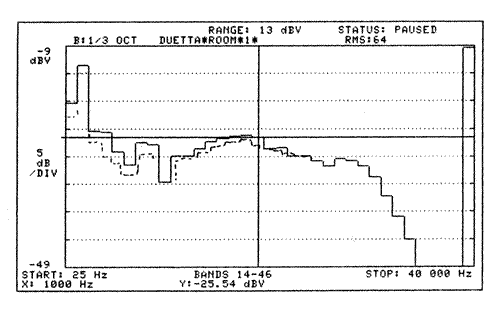
FIG.4Larger rooms would definitely improve the Duetta's bass-mid balance, though the low bass would remain over powerful down to 30Hz. For the benefit of those readers not familiar with these room-averaged responses, I can assure you that it is possible to obtain a room curve using this method which runs within ± 3dB 25Hz to 200Hz, ±2dB 200Hz to 8kHz, with a gentle roll-off thereafter. (This latter effect is due to the finite directivity of almost all commercial tweeters at higher frequencies.) Blind listening tests have shown a consistently good correlation between perceived response and the room measurement.
Technical Test Results: Martin-Logan CLS
Looking at the amplifier load factor, the impedance curve (fig.5) is typically electrostatic. Low at low frequencies, and with no visible signs of the 50Hz diaphragm resonance, it climbs steeply to a harmless 33 ohms by 1kHz. Above this level, the load is almost purely capacitive, falling with frequency at 6dB/octave, reaching 2.5 ohms at 10kHz and finally bottoming out at a value of 1.6 ohms at 20kHz. Wide-band synthesizers played at high level will not do the amplifier-speaker combination much good, while this load non-uniformity will cause more treble balance variations than usual with different cables and different amplifiers. In fact, one or two power amps may not be too stable with this load under heavy transient drive.
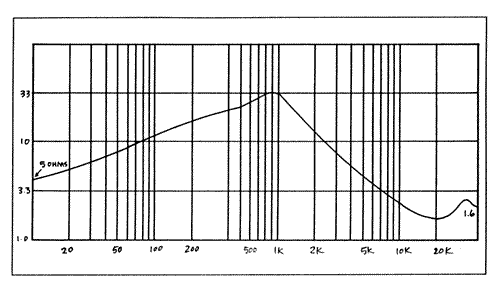
FIG.5The CLS frame assembly seemed to show a minor mechanical resonance that was checked out acoustically (fig.6) and clearly placed at 160Hz. This resonance could be picked out on nearly all response curves taken.
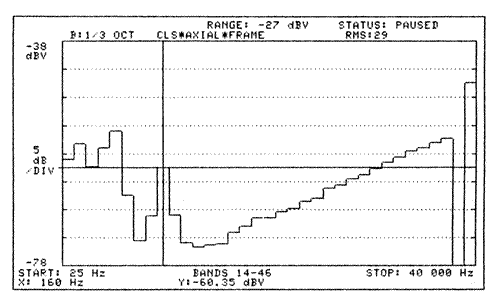
FIG.6The forward response set is shown in fig.7. Taking the solid axial line first, the speaker output was high in the midrange, partly due to proximity. Above 1kHz, the output was even and well-extended, suggesting a basically good tonal balance. No loss was seen by 20kHz. The low frequencies also deserve some comment. As predicted by Gayle Sanders Of Martin-Logan, the main resonance was precisely at 50Hz, and, in my view, showed excessive amplitude. The bands above 50Hz were deficient, while a steep roll-off held below 50Hz, the output already -8dB by 40Hz, and -18dB by 30Hz.
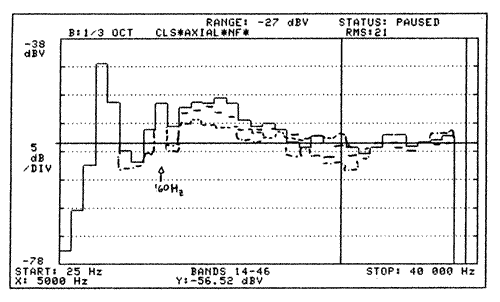
FIG.7Given the smoothing advantage provided by 1/3-octave analysis, the off-axis responses of the CLS were remarkably good. It held a well-extended response over a wide range of angles, ±15 degrees vertical and up to 45 degrees horizontally This is shown by the commendable closeness of the off-axis response group.
To explore the subjective comment of phasiness, a narrow-band analysis was performed in the 500Hz-20.5kHz range for the axial response, and for a small 5-degree lateral angle change (fig.8).
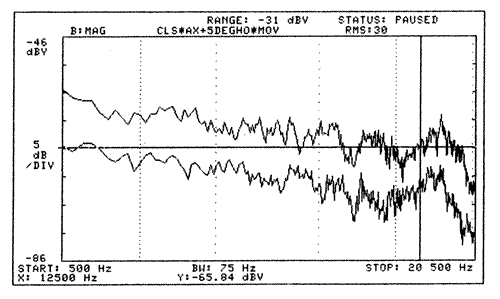
FIG.8The results show that the CLS does have a peak at 15-16kHz (heard on audition), and that the two responses, although subjectively alike, do not correlate well. Inter-response differences of 3-5dB are frequent at high frequencies, which, of necessity, imply quite rapid phase shifts. These effects are typical of a multi-sourced, multi-lobed treble radiating system-the multiple cell configuration. The computer-averaged room response (fig.9) provides the final stage of measurement analysis.
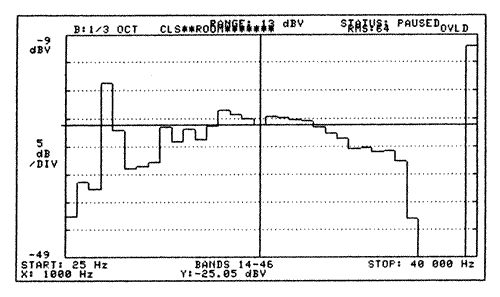
FIG.9Here the 50Hz resonance can be clearly seen, while the energy loss above 60Hz is also apparent. The broad midrange is well balanced, while the upper treble is a little too well-extended at the highest extremity, suggesting an aural edge or corner. This is associated with the 16kHz axial prominence.
Without claiming sonic superiority for the Quad 63, the response for this model under identical conditions (fig.10) makes for an Interesting comparison. Quad has attained a commendably uniform bass to 30Hz, with a broad sweep of uniform output held over the entire range, culminating in a naturally smooth room-energy roll-off in the highest frequencies. Yes, it can be done!
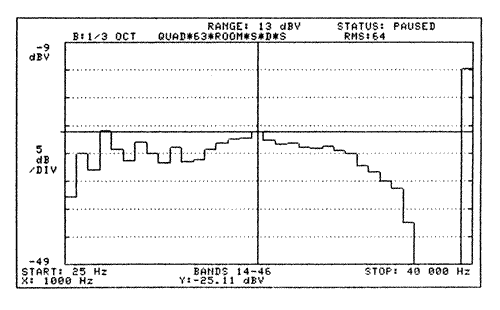
FIG.10The CLS offered a below-average sensitivity of 84dB/W, with a power handling of 100W per channel. Maximum room sound levels of typically 100dBA will be possible, though the speaker generally seemed to sound a mite louder than that.
Technical Test Results: Magneplanar MGIIIa
I could not resist a sneak look at this speaker while it was passing through the lab.
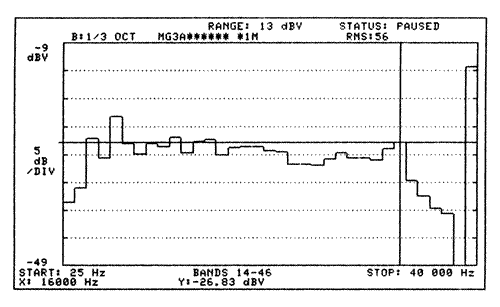
FIG.11Fig.11 is a snapshot of the forward axial response, showing some lift up to 16kHz. The mid-treble is linear and well integrated, while the bass is more or less level to 40Hz, in good proportion with the rest.
The response in the listening room (fig.12) was remarkable at first sight, although the upper treble was just too good to be true. In addition, the moderate prominence at 60-80Hz could ideally have been avoided. This curve confirms both the inherent neutrality of the IIIa, and its newfound extension to 25Hz in-room.
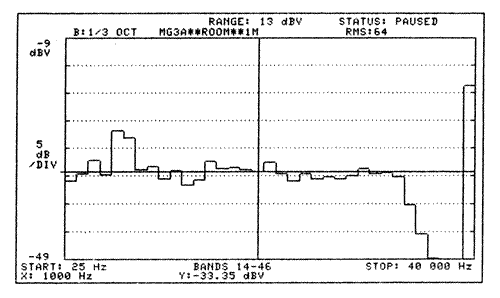
FIG.12Conclusion
I was fortunate in having access to all three speakers at once during this three-way contest (though I am sure my wife did not agree!).
Because the final purchase decision must include major considerations such as required loudness, room size, speaker placement, available amplification, and the amplifier/speaker Interface, I find it hard to pick a winner. The kind of music played may also be important, while matters of personal taste on tonal balance are also crucial.
Given a near-unlimited amplifier budget, my ultimate sympathies lie with the Duetta II. As a reviewer, however, I could not cope with it in its present state. It is simply too rich, tonally, too insensitive to use as a reviewing tool; If intended as the basis for a music room ... well, that would be another matter! If the diminished final octave does not matter too much, and if really high sound levels are not required, and if a large room is also available (quite a few ifs!), then the Duetta is the best choice. There is no doubt that its intrinsic quality was in the highest class, and implied no limit in terms of the matching amplifier quality; the ARC M100 proved this, though it didn't achieve a sensible volume level.
I would ask Apogee to consider an approved modification for bypassing the crossover. Dan D'Agostino could then work up a nice equalized electronic crossover, working in conjunction with a pair of KSA-100s, to provide direct-coupled, bi-amped operation. I confidently predict that this combination would provide one of the finest performances for the money presently available in the businesses. *
* Provisions have been made for the Duetta Series II to he driven via an active crossover. Owners should consult the manual for instructions.
I find the CLS has considerable merit, particularly for smaller orchestral forces, offering an essentially uncoloured, fast sound. Reservations remain, however, concerning the non-uniform impedance load, the peak midrange power-handling for Its price and size class, the treble phasiness and related fine structure Irregularities, and, finally, the almost one-note 50Hz bass.
The CLS is an interesting speaker of remarkable appearance. Only a careful audition will properly inform a prospective customer, especially since broad areas of its frequency range sound quite as transparent as it looks.
Finally, we have the well-established Magneplanar MGIIIa, which has not suffered too greatly in these comparisons. Of eminently reasonable sensitivity, easy to drive, and possessing an essentially neutral tonal balance, it also has a notably wide frequency response, which survived well in my 20-foot long, 80m³ room. In no way can it be dismissed as old technology. Admittedly, the Maggie's mid did not reach the peak of the Duetta or the CLS but it was nonetheless good. In the long term, its overall engineering integrity told in its favour, to which must be added the ease of amplifier rating matching.
Reprinted from Stereophile Vol.10 No.1